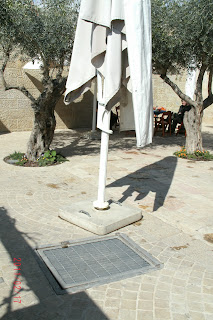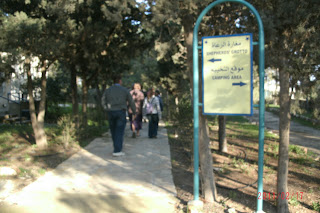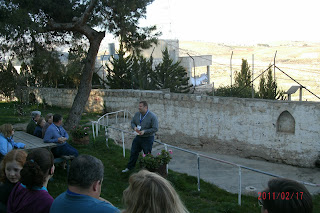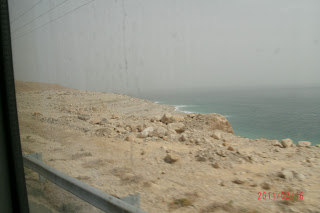Exodus and Holy Land Tour
Friday, February 18, 2011
Feb. 18 Quick update
As much as we have loved posting the blog, you will have to wait for our final day in pictures. We had a long day and wonderful evening meal made especially for our last night. We sang together for an hour but had to get up at 2AM in order to be at the airport on time. I'm sure you understand! If we have a signal in London, I will try to do our final post during our 5 hour layover. We are looking forward to getting home and seeing you all.
Thursday, February 17, 2011
Feb. 17 Jerusalem and Bethlehem
A Jerusalem morning. Beautiful weather for a day of touring.
The southern steps going up to the Temple. Jesus used these each time He went to the Temple.
The ascent to the Temple Mount.
This does not belong. The smaller dome on the Temple Mount.
This does not belong either. The Dome of the Rock.
Beauty and splendor for certain. The architecture and lines can be appreciated, but how it stirs the heart to anger that this structure sits in the place where the Temple ought to be. We were not even allowed to carry Scripture up here. If Mark had shown any of his Temple drawings he would have gotten in serious trouble from the guards. How sad that Israel allowed for the Muslims to keep this area as their own. Some think that it has been a work of God's providence because it is possible the Ark of the Covenant is buried under the Dome. We will not know for certain where it is until God chooses to give it back to His people.
A view of the Mount of Olives from the Eastern Gate of the Temple Mount.
The Matthews family has been a lot of fun to spend our time with. They are sweet people!
This is the Eye of the Needle. Some argue that Jesus was speaking literally of a needle's eye. Others will argue that it was the small opening in a gate. Either way, it is impossible to fit a camel through.
Old City Jerusalem. Everything is up hill here!
Huh? How do those two foods fit together as a restaurant's main menu items?
A rebuilt synagogue that was destroyed by the Jordanians.
The old main street of Jerusalem.
A view down an old main street excavation shaft. This goes down several levels to before the time of Christ.
Candelstick Chris. I got to play the part of the menorah at the Temple Institute. There are no pictures of the Institute because they would not allow us to take them. They are preparing all of the instruments and clothing for the future Temple. They have most everything ready and are even training priests in the event that the Temple is rebuilt. How sad that they are still looking to the Temple and priesthood to be the mediator between God and man. If only they would open their hearts to their Mediator who has already come, died, and rose again.
The women's side of the Wailing Wall.
The men's side of the Wailing Wall. On the right, they are reading the Scripture and having multiple Bar Mitzvahs. I wonder how many of the prayers are for the Messiah to hasten His coming. How sad that most, if not all, of the Jews standing here would go to Hell if they met death today. They are still depending on the traditions and rituals of the law. How badly they need to see that Messiah has already come. Even our guide, Mark, wants to see what we Christians see in Jesus but he just can't.
A picture of the Bar Mitzvah celebration after the boys have read the Scripture and are now considered men. The women stand on chairs and peer over the wall to take part in the celebration. While we were watching from the outer courtyard, the women were throwing candy over the fence as part of the celebrating.
This is the area where David built his palace.
This is a covered cistern. It is thought that the prophet Jeremiah may have been thrown down into this cistern.
For some reason the picture of Pastor Matthews standing in front of the Pool of Siloam will not show up. Maybe it will show up for you after the blog is posted.
The Valley of Hinom. This is where babies were caused to pass through the fire to Molech. Molech was a big iron statue with a furnace in the belly. Devout followers would cast their live babies into the fire as a sacrifice to their God. It is said that the drums would beat loudly and constantly to drown out the screams of the babies and their parents. How could the people of Israel be drawn into such idolatry. Even some of the kings, Ahaz and Manasseh, were drawn into this wicked worship.
Lunch at the Ramat Rachal kibbutz. Nice place, but expensive just like everywhere else in Israel. This small salad, bread, and dessert cost a little over $11 USD.
A panoramic view of the city of Jerusalem from around the 68AD era. This is a 50:1 scale model found at the Israel Museum.
A scale model of Herod's Temple in the Jerusalem model.
Another view of the city.
This is the roof of the building that houses the Dead Sea scrolls/findings at the Israel Museum. They will not allow pictures inside in order to preserve the scrolls and items on display.
Walking down the trail to a cave in Bethlehem. We did not visit the traditional spot of the nativity because it is so commercialized and "iconized" by the Catholic Church. Leave it to the traditions of men to ruin something that is probably not even the real thing.
We met in the cave and sang Christmas carols.
Devotions on the hillside in Bethlehem. We looked at the story of Ruth and Boaz. Bethlehem is the place of the Kinsman redeemer.
A view of the Old City Bethlehem. It is a much larger city today. In fact, there is no break between the city of Jerusalem and the city of Bethlehem. It sure does make a difference to know how close these places were. Israel is a small country with a lot of climates and landscapes.
We got back to the hotel late and got supper. We have another early morning tomorrow. Sorry for the change in the posting style. I'm sure it helps with the pictures, but we are on information overload from all of the sights and instruction that Mark gave us today. Tomorrow is the Mount of Olives, the Garden Tomb, Golgotha, and the Upper Room.
Wednesday, February 16, 2011
Feb. 16 The Dead Sea Valley: Masada and Qumran then up to Jericho
After an early wake up call we boarded our bus and descended for an hour to 1300 feet below sea level. This is the lowest point on the face of the earth. As we drove along the route to the Dead Sea we could see the Mount of Olives and the Dome of the Rock off in the distance. I was surprised at the emotion that stirred in my heart in seeing an Islamic monument in the place where the Temple should be. We know that when the rapture takes place that it will be a different story. Later this week we will see how the Jews are preparing for the future Temple to be rebuilt. They are even close to engineering the breed to have the ability to produce the red heifer necessary to purify the priests.
The Dead Sea valley is a place of beauty and barrenness. There is evidence of the flash floods seen in the white washed crevices where water, sediment, and rock are forced down to the valley by the vehement flood waters. There is definitely a solitude and dependence upon God for survival in the wilderness. It is a dangerous place. The necessity of the oasis for life is very evident. The Israelis though have capitalized on the deadness and brought life through the mineral production from the Dead Sea.
Masada was a moving experience. Brought to glory by Herod the Great, it was a near impenetrable fortress that had the capability to sustain life for a thousand people for nearly forty years. This was a strong hold against possible invaders and was the place of a sad story of Roman cruelty and the Jewish love of freedom. Near 73AD the Romans sieged a group of almost one thousand Jews who fled Jerusalem after the destruction of the Temple by Titus. For nearly two years the Romans encamped around this strong hold and built a siege ramp up to the western gate. The night that the Romans broke through, Eleazar Ben Yair, the leader of the Jews, gave a speech that lead them to a very sad and unforgotten tragedy. The men all took their families back to their homes and killed their wives and children, knowing that if the Romans founds them alive that they would be raped and ravaged then thrown into slavery. The men then drew lots for ten who would kill all the others and then the ten drew lots for one who would kill the ten and then fall on his own sword. The Romans were shocked to find the dead and their weapons burned. The only thing left behind was a little food to show that they were not starving and a few old women and children who had hidden from death and were able to tell the story. Even those few were shown no compassion but were made slaves.
Next we drove a short distance to En Gedi where David met Saul and spared his life in a cave. Pastor Matthews read the passage where David entreated Saul for his life. We were able to look over into the park (which had been closed due to the danger of winter flash flooding) and see the three water falls from the springs which are there. This is a true place of beauty in such a barren land.
Qumran was our next stop. This is the location where the Dead Sea scrolls were found. Qumran, before the Roman obliteration around 70AD, was inhabited by a group called the Essenes. This was a religious sect that started somewhere around 2BC. They were unhappy with the priesthood in Jerusalem and saw it as corrupt and unclean so they moved to the dessert. This is the first known monastic group in history. There is much more that can be said about them, but the importance of Qumran is the finding of the scrolls that had been there and copied there during the period the Essenes occupied the city. It is believed that during the Roman conquest they hid the scrolls in caves west of the city to be recovered after they came back. That never happened and the scrolls sat until discovered in the twentieth century. What a joy to see not only the promise of God to preserve His word, but also the confirmation that the Old Testament we have today is accurate in comparison to these scrolls that are a thousand years older than any previous manuscripts we had.
After lunch, we went down to the Dead Sea. The water with no life has some amazing properties. Not only is it so dense that the human body will float, but also its minerals and mud have unique healing and health properties. It was strange to see everyone lying on their backs and floating but even stranger to see everyone smearing mud on their arms, legs, and faces. Interestingly enough, you do feel different after being in the water. My skin felt very soft and my skin was very salty even after showering off. Israel makes a lot of money processing the salt, minerals, and chemicals that exist in the Dead Sea. The Dead Sea skin products are definitely worth checking into!
Finally, on to Jericho. We dropped off Mark, our guide, and then our bus driver, Muhommed, became our “guide” into Jericho. Mark cannot accompany us because Jericho is under Palestinian control. Side note, one of the things we have noticed is that the countries outside of Israel are very depressed and dirty. Even Jericho has a dirty, oppressive feel. What a joy it will be when we will be able to see it under our Lord’s reign. Pastor Nason delivered a short message on the tel of old Jericho, reminding us of God giving us power and victory in our lives. As we sat, the Mount of Temptation was behind us. After leaving the tel, we passed by the traditional tree that Zacchaeus climbed to see Jesus. We ended our day with a little shopping at the glass shop.
Tomorrow we will head to the Temple Mount, the Mount of Olives, and various spots surrounding Jerusalem. Until tomorrow, Shalom Shalom!
Subscribe to:
Posts (Atom)




























































